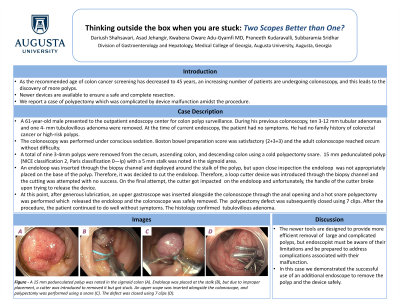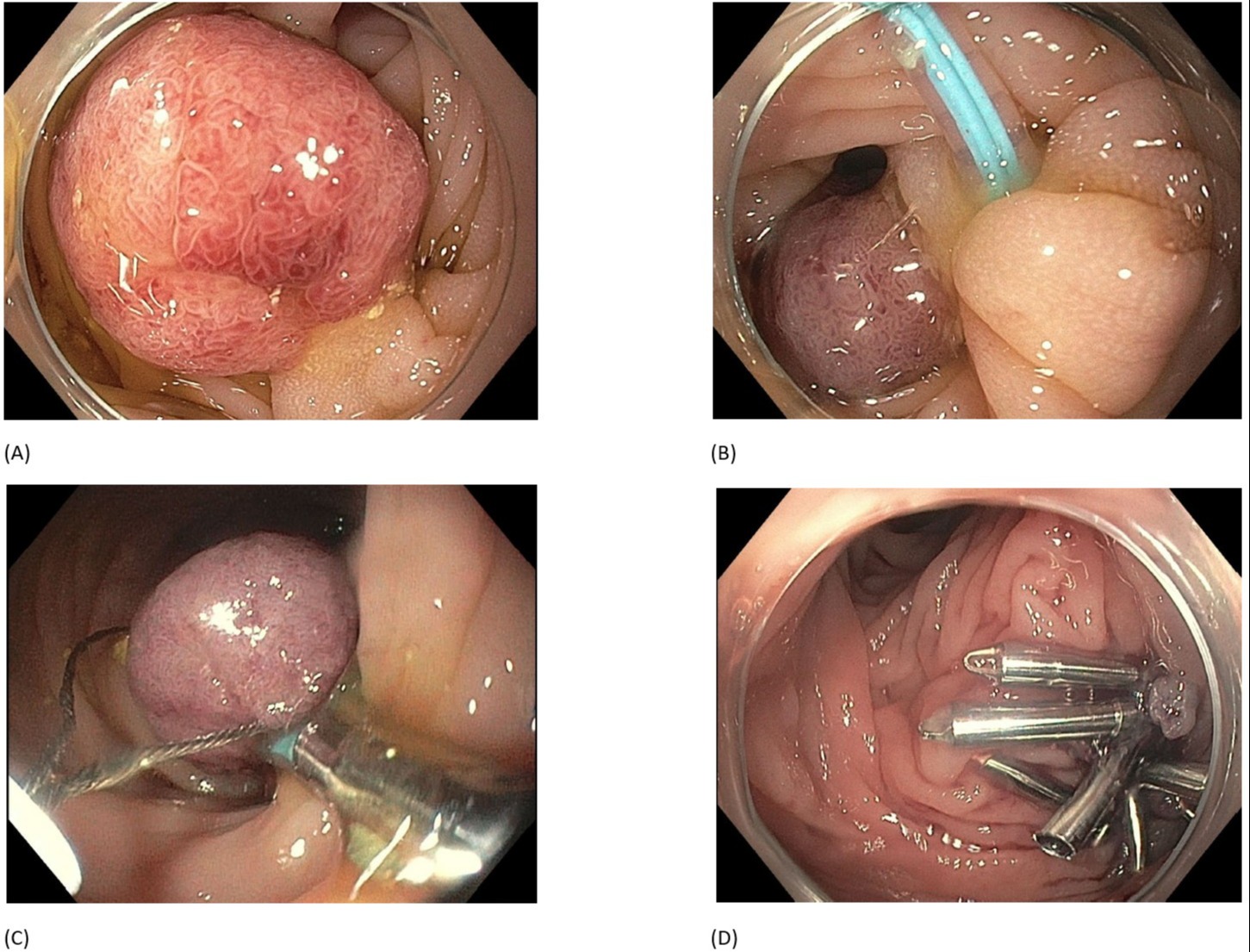Tuesday Poster Session
Category: General Endoscopy
P3429 - Thinking Outside the Box When You Are Stuck: Two Scopes Better Than One?
Tuesday, October 24, 2023
10:30 AM - 4:00 PM PT
Location: Exhibit Hall

Has Audio

Dariush Shahsavari, MD
Medical College of Georgia
Augusta, GA
Presenting Author(s)
Dariush Shahsavari, MD1, Asad Jehangir, MBBS2, Kwabena Adu-Gyamfi, MD3, Praneeth Kudaravalli, MD2, Subbaramia Sridhar, MBBS, MPH4
1Medical College of Georgia, Augusta, GA; 2Augusta University, Augusta, GA; 3Medical College of Georgia at Augusta University, Augusta, GA; 4Augusta University Medical Center, Augusta, GA
Introduction: As the recommended age of colon cancer screening has decreased to 45 years, an increasing number of patients are undergoing colonoscopy, and this leads to the discovery of more polyps. Newer devices are available to ensure a safe and complete resection. We report a case of polypectomy which was complicated by device malfunction amidst the procedure.
Case Description/Methods: A 61-year-old male presented to the outpatient endoscopy center for colon polyp surveillance. During his previous colonoscopy, ten 3-12 mm tubular adenomas and one 4- mm tubulovillous adenoma were removed. At the time of current endoscopy, the patient had no symptoms. He had no family history of colorectal cancer or high-risk polyps.
The colonoscopy was performed under conscious sedation (8 mg of midazolam, 150 mcg of fentanyl, and 50 mg of diphenhydramine). Boston bowel preparation score was satisfactory (2+3+3) and the adult colonoscope reached cecum without difficulty. A total of nine 3-4mm polyps were removed from the cecum, ascending colon, and descending colon using a cold polypectomy snare. A 15 mm pedunculated polyp (NICE classification 2, Paris classification 0—Ip) with a 5 mm stalk was noted in the sigmoid area. An endoloop was inserted through the biopsy channel and deployed around the stalk of the polyp, but upon close inspection, the endoloop was not appropriately placed on the base of the polyp. Therefore, it was decided to cut the endoloop. A loop cutter device was introduced through the biopsy channel and the cutting was attempted with no success. On the final attempt, the cutter got impacted on the endoloop and unfortunately, the handle of the cutter broke while trying to release the device. At this point, after generous lubrication, an upper gastroscope was inserted alongside the colonoscope through the anal opening and a hot snare polypectomy was performed which led to the successful release of the jammed endoloop and the colonoscope and they were safely removed. The polypectomy defect was subsequently closed using 7 clips. After the procedure, the patient continued to do well without symptoms. The histology confirmed tubulovillous adenoma.
Discussion: The newer tools are designed to provide more efficient removal of large and complicated polyps, but endoscopist must be aware of their limitations and be prepared to address complications associated with their malfunction. In this case we demonstrated the successful use of an additional endoscope to remove the polyp and the malfunctioning device safely.

Disclosures:
Dariush Shahsavari, MD1, Asad Jehangir, MBBS2, Kwabena Adu-Gyamfi, MD3, Praneeth Kudaravalli, MD2, Subbaramia Sridhar, MBBS, MPH4. P3429 - Thinking Outside the Box When You Are Stuck: Two Scopes Better Than One?, ACG 2023 Annual Scientific Meeting Abstracts. Vancouver, BC, Canada: American College of Gastroenterology.
1Medical College of Georgia, Augusta, GA; 2Augusta University, Augusta, GA; 3Medical College of Georgia at Augusta University, Augusta, GA; 4Augusta University Medical Center, Augusta, GA
Introduction: As the recommended age of colon cancer screening has decreased to 45 years, an increasing number of patients are undergoing colonoscopy, and this leads to the discovery of more polyps. Newer devices are available to ensure a safe and complete resection. We report a case of polypectomy which was complicated by device malfunction amidst the procedure.
Case Description/Methods: A 61-year-old male presented to the outpatient endoscopy center for colon polyp surveillance. During his previous colonoscopy, ten 3-12 mm tubular adenomas and one 4- mm tubulovillous adenoma were removed. At the time of current endoscopy, the patient had no symptoms. He had no family history of colorectal cancer or high-risk polyps.
The colonoscopy was performed under conscious sedation (8 mg of midazolam, 150 mcg of fentanyl, and 50 mg of diphenhydramine). Boston bowel preparation score was satisfactory (2+3+3) and the adult colonoscope reached cecum without difficulty. A total of nine 3-4mm polyps were removed from the cecum, ascending colon, and descending colon using a cold polypectomy snare. A 15 mm pedunculated polyp (NICE classification 2, Paris classification 0—Ip) with a 5 mm stalk was noted in the sigmoid area. An endoloop was inserted through the biopsy channel and deployed around the stalk of the polyp, but upon close inspection, the endoloop was not appropriately placed on the base of the polyp. Therefore, it was decided to cut the endoloop. A loop cutter device was introduced through the biopsy channel and the cutting was attempted with no success. On the final attempt, the cutter got impacted on the endoloop and unfortunately, the handle of the cutter broke while trying to release the device. At this point, after generous lubrication, an upper gastroscope was inserted alongside the colonoscope through the anal opening and a hot snare polypectomy was performed which led to the successful release of the jammed endoloop and the colonoscope and they were safely removed. The polypectomy defect was subsequently closed using 7 clips. After the procedure, the patient continued to do well without symptoms. The histology confirmed tubulovillous adenoma.
Discussion: The newer tools are designed to provide more efficient removal of large and complicated polyps, but endoscopist must be aware of their limitations and be prepared to address complications associated with their malfunction. In this case we demonstrated the successful use of an additional endoscope to remove the polyp and the malfunctioning device safely.

Figure: Figure 1- A 15 mm pedunculated polyp was noted in the sigmoid colon (A). Endoloop was placed at the stalk (B),Due to improper placement, a cutter was introduced to removed it, but it got impacted on the endoloop.. An upper scope was inserted alongside the colonoscope, and polypectomy was performed using a standard snare (C). The defect was closed using 7 clips (D).
Disclosures:
Dariush Shahsavari indicated no relevant financial relationships.
Asad Jehangir indicated no relevant financial relationships.
Kwabena Adu-Gyamfi indicated no relevant financial relationships.
Praneeth Kudaravalli indicated no relevant financial relationships.
Subbaramia Sridhar indicated no relevant financial relationships.
Dariush Shahsavari, MD1, Asad Jehangir, MBBS2, Kwabena Adu-Gyamfi, MD3, Praneeth Kudaravalli, MD2, Subbaramia Sridhar, MBBS, MPH4. P3429 - Thinking Outside the Box When You Are Stuck: Two Scopes Better Than One?, ACG 2023 Annual Scientific Meeting Abstracts. Vancouver, BC, Canada: American College of Gastroenterology.
